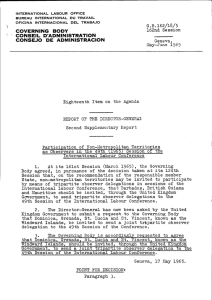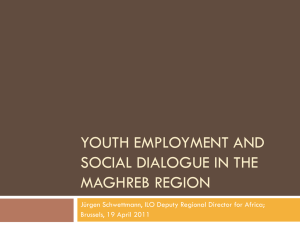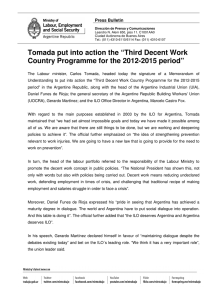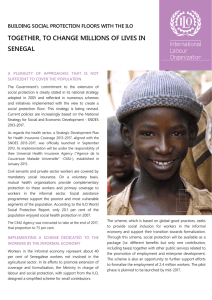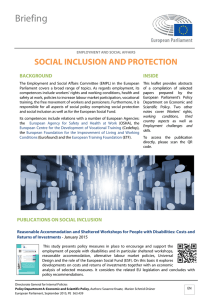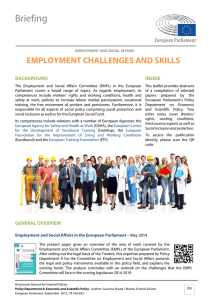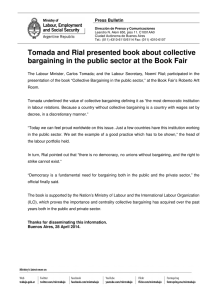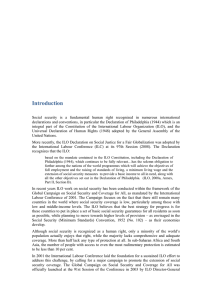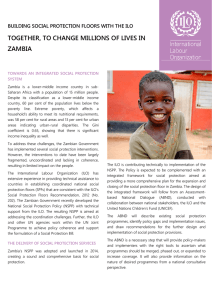The Distribution of Hours of Work in Developed and
Anuncio
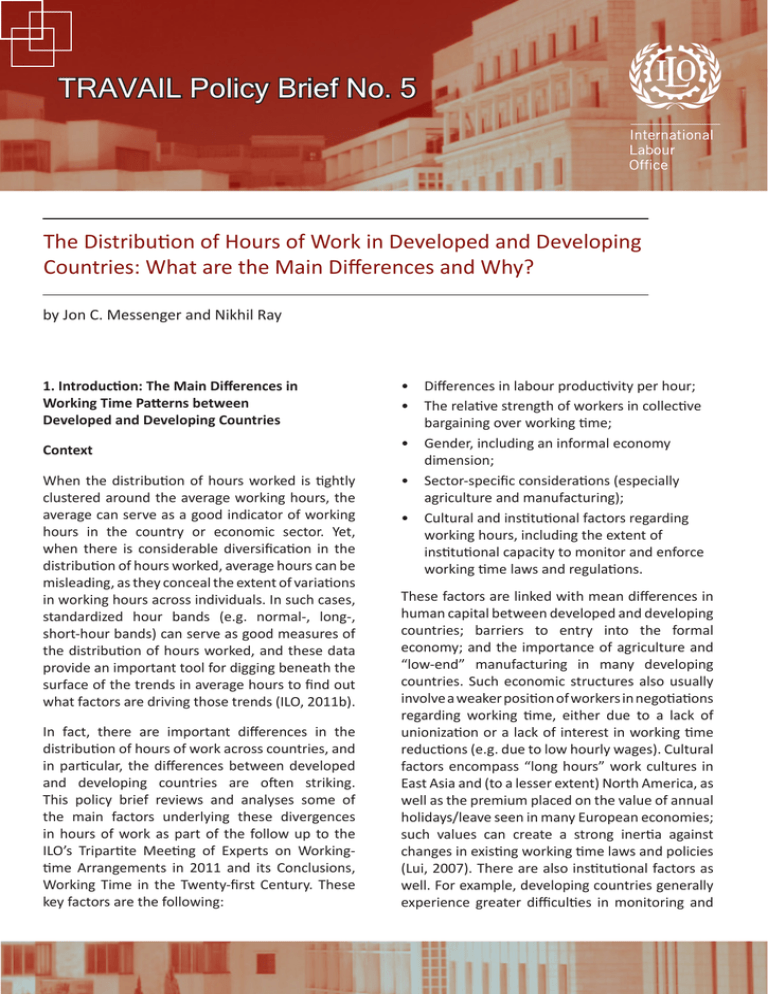
TRAVAIL Policy Brief No. 5 The Distribution of Hours of Work in Developed and Developing Countries: What are the Main Differences and Why? by Jon C. Messenger and Nikhil Ray 1. Introduction: The Main Differences in Working Time Patterns between Developed and Developing Countries Context When the distribution of hours worked is tightly clustered around the average working hours, the average can serve as a good indicator of working hours in the country or economic sector. Yet, when there is considerable diversification in the distribution of hours worked, average hours can be misleading, as they conceal the extent of variations in working hours across individuals. In such cases, standardized hour bands (e.g. normal-, long-, short-hour bands) can serve as good measures of the distribution of hours worked, and these data provide an important tool for digging beneath the surface of the trends in average hours to find out what factors are driving those trends (ILO, 2011b). In fact, there are important differences in the distribution of hours of work across countries, and in particular, the differences between developed and developing countries are often striking. This policy brief reviews and analyses some of the main factors underlying these divergences in hours of work as part of the follow up to the ILO’s Tripartite Meeting of Experts on Workingtime Arrangements in 2011 and its Conclusions, Working Time in the Twenty-first Century. These key factors are the following: • Differences in labour productivity per hour; • The relative strength of workers in collective bargaining over working time; • Gender, including an informal economy dimension; • Sector-specific considerations (especially agriculture and manufacturing); • Cultural and institutional factors regarding working hours, including the extent of institutional capacity to monitor and enforce working time laws and regulations. These factors are linked with mean differences in human capital between developed and developing countries; barriers to entry into the formal economy; and the importance of agriculture and “low-end” manufacturing in many developing countries. Such economic structures also usually involve a weaker position of workers in negotiations regarding working time, either due to a lack of unionization or a lack of interest in working time reductions (e.g. due to low hourly wages). Cultural factors encompass “long hours” work cultures in East Asia and (to a lesser extent) North America, as well as the premium placed on the value of annual holidays/leave seen in many European economies; such values can create a strong inertia against changes in existing working time laws and policies (Lui, 2007). There are also institutional factors as well. For example, developing countries generally experience greater difficulties in monitoring and enforcing the implementation of their labour standards, including normal and maximum working hours legislation, due to limitations in institutional capacity (e.g. understaffing of the labour inspectorates). Western Europe the smallest ones. There are significant divergences in the distribution of hours linked to gender, especially with women making much greater use of shorter hour schemes such as part-time work arrangements in developed countries, often due to family responsibilities. Another important source of divergence in hours of work is the worker’s employment status: self-employed workers are more likely to have either long or short hours than workers in wage and salary employment (ILO, 2011b). In developing countries, selfemployed workers make up a significant portion of the labour force, owing to the size of the informal economy. Key Definitions For this policy brief, long hours are defined as those hours of work exceeding 48 hours per week, in line with ILO Conventions Nos. 1 and 30. In contrast, short hours can be defined as less than 35 hours per week or less than 30 hours per week depending on the national jurisdiction, while other countries leave it up to workers’ self-definition when they respond to the labour force survey. For the purpose of comparability, a 35-hour threshold is used for short hours for all of the countries analysed in this policy brief. Figure 1.1 illustrates the average weekly hours worked in a selection of developing, transition and developed countries. Developing countries exhibit longer hours on average, frequently above 40 hours per week, with Saudi Arabia and Turkey reaching nearly 50 hours per week. In contrast, the average weekly hours of developed countries are concentrated in the 30-40 hour per week range, with the notable exceptions of Japan, the Republic of Korea and Singapore, i.e. several of the East Asian “long-hours culture” economies. General Observations Workers in developing countries tend to work longer hours than in developed countries, with Asia exhibiting the highest proportions of workers working long hours on average and Fig. 1.1: Average Weekly Hours worked in Selected Countries, 2000 to present (Source: Eurostat; ILO, Working time in the twenty-first century: Report for discussion at the Tripartite Meeting of Experts on Working-time Arrangements, 2011; National Statistical Offices) 60 Developed countries Developing and transition countries 50 40 30 20 10 0 2000 or closest 2005 or closest Most recent year* * Whenever possible, data for the years 2009 or 2010 have been used; for Australia, Brazil, Mauritius, Morocco and Peru, only data for 2008 were available. 2 Fig. 1.2A: Percentage of Persons working Long Hours in Developing and Transition Countries (Total Employment) (Source: Eurostat; ILO, Working time in the twenty-first century: Report for discussion at the Tripartite Meeting of Experts on Working-time Arrangements, 2011; National Statistical Offices) 100% 90% 80% 70% 60% 50% 40% 30% 20% 10% 0% 2000 or closest year 2005 or closest year Most recent year** ** Whenever possible, data for the years 2010 or 2009 have been used. Due to the availability of data, for Brazil, Morocco, Peru and the Russian Federation 2008 has been used. The global economic crisis might have had an impact on the 2009 data. Fig. 1.2B: Percentage of Persons working Long Hours in Developed Countries (Total Employment) (Source: Eurostat; ILO (2011), Working time in the twenty-first century: Report for discussion at the Tripartite Meeting of Experts on Working-time Arrangements; National Statistical Offices) 100% 90% 80% 70% 60% 50% 40% 30% 20% 10% 0% 2000 or closest year 2005 or closest year Most recent year** ** 2010 or 2009. The global economic crisis might have had an impact on the 2009 data. Figures 1.2A and 1.2B highlight the contrast between the percentage of people working long hours (i.e. more than 48 hours per week) in selected developed countries and those working long hours in selected developing and transition countries. Excluding Bulgaria, Chile and the Russian Federation, the selected developing and transition countries have more than 20% of their populations working long hours; in this context, it should be noted that Bulgaria and the Russian Federation are transition economies, while Chile is expected to become the first Latin American country to reach developed status (Williamson, 2009). In the selected developed countries shown here, the Republic of Korea and Singapore have the highest proportion of their working population working long hours. 3 Fig. 1.3A: Percentage of Persons working Short Hours in Developing and Transition Countries (Total Employment) (Source: Eurostat; ILO, Working time in the twenty-first century: Report for discussion at the Tripartite Meeting of Experts on Working-time Arrangements, 2011; National Statistical Offices) 100% 90% 80% 70% 60% 50% 40% 30% 20% 10% 0% 2000 or closest year 2005 or closest year Most recent year** ** Whenever possible, data for the years 2010 or 2009 have been used. Due to the availability of data, for Brazil, Morocco, Peru and the Russian Federation 2008 has been used. The global economic crisis might have had an impact on the 2009 data. of more traditional workday patterns in these formerly communist transition countries. In Figure 1.3B, France1 and the Netherlands have the highest proportions of workers engaged in short-hours work, with 42% and 44% in 2010 respectively. Anxo (2009) notes an interesting trend in Sweden, where fewer women workers are engaging in short-hours (part-time) work, in favour of moving into normal hours/full-time work. Figures 1.3A and 1.3B outline the differences in the percentage of the labour force working short hours (i.e. less than 35 hours per week) in selected developing, transition and developed countries. Among the developing countries examined, Argentina and Peru have the highest number of workers working short hours, with 32% and 37% respectively. Bulgaria and the Russian Federation have the lowest rates, reflecting the persistence Fig. 1.3B: Percentage of Persons working Short Hours in Developed Countries (Total Employment) (Source: Eurostat; ILO, Working time in the twenty-first century: Report for discussion at the Tripartite Meeting of Experts on Working-time Arrangements, 2011; National Statistical Offices) 100% 90% 80% 70% 60% 50% 40% 30% 20% 10% 0% 2000 or closest year 2005 or closest year ** 2010 or 2009. The global economic crisis might have had an impact on the 2009 data. 4 Most recent year** 2. Analysis of Key Factors Underlying the Differences in Working Time Patterns Lower levels of productivity per hour stems in part from less education/training and consequently lower human capital (Becker, 1993); other factors resulting in lower productivity levels per hour include poor work organization, lack of equipment, and limited access to information and communications technologies. The lower average wages also reflect developing countries’ relative abundance of labour relative to capital: in many sectors of the economy, employers can afford to pay less for the lower skills set, as they have a large pool of workers from which to recruit. Even with semi-skilled workers, their ability to command shorter working hours, or higher wages for that matter, is curtailed by a lack of bargaining power vis-à-vis the employer, due to low levels of unionization and sometimes the employer’s monopsony2 power. In addition, low wages result in workers working longer hours in order to be able to earn enough to survive (as noted above). In contrast, developed countries rely on a more highly-skilled workforce and are consequently subject to efficiency wage Economic Factors The most common explanation for the observed differences in the distribution of working hours between developed and developing countries arises from differences in productivity per hour and hourly wages. Workers in developing countries are less productive and receive a lower wage per hour, and so need to work longer hours in order to earn enough income to be able to survive. Such differences can also explain some of the variance in hours of work within developed countries: for example Greece works the longest average annual hours in the EU and also has substantially lower levels of productivity per hour than other developed countries in the EU. In contrast, the fact that workers in EU Member States such as France, Germany and the Netherlands work considerably fewer hours is linked with their higher mean productivity per hour. Fig. 2.1 Share of Employed Persons Working 40 Hours or More per Week and Labour Productivity (GDP per hour worked at current US Dollar Prices), 2009. (Source: ILO, Summary of the Key Indicators of the Labour Market (7th Ed.), ILO: Geneva) 100% Hungary Percentage of employed population working 40 hours or over 90% Poland Estonia Czech Republic Slovenia Slovakia Greece 80% Portugal 70% New Zealand Luxembourg Iceland Japan Spain Switzerland Italy Sweden Austria 60% Germany Canada 50% U.K. Australia Finland 40% France 30% NL Ireland Belgium 20% Norway Denmark R² = 0.8489 10% 0% USD 20 USD 30 USD 40 USD 50 USD 60 GDP per hour worked at current prices in USD 5 USD 70 USD 80 Gender arguments: that is, higher wages are associated with higher productivity per hour, which allows workers to enjoy more leisure time while still earning enough to meet their needs - thus resulting in reduced working hours. Finally, it should also be noted that the availablity of social transfer payments (e.g., family allowances) provide households with non-labour income that may reduce the pressure to work long hours in employment. Gender is an important factor affecting the distribution of hours of work insofar that women seek working hour arrangements compatible with domestic and family duties. Even in many developed countries, traditional gender roles continue to prevail, with women fulfilling the vast majority of household and care tasks—even if they are also the main “bread-winners”. In developing countries, there is a marked difficulty for women to secure paid part-time work, which often compels them to opt for self-employment, and consequently non-wage work in the informal economy to supplement their household’s income (McKee et al., 1993; Datta, 2003). This arrangement is frequently the only one available which allows them to bolster their incomes without detracting too much from their domestic responsibilities. Likewise, due to traditional roles within the family and society, men are more likely to prefer to work longer hours in paid work and gain higher total earnings, particularly in developing countries. Data from the ILO’s Key Indicators of the Labour Market (KILM) Database illustrates some of the patterns discussed above in Figure 2.1, with the less affluent transition countries (e.g. Czech Republic, Estonia, Hungary, Poland) exhibiting 80% or more of their labour force working more than 40 hours per week, while the richer developed countries (Belgium, France, Ireland, the Netherlands, Norway) have less than 35% of their labour force working more than 40 hours per week. Luxembourg is an interesting outlier, with a high productivity per hour worked (75 USD/hour) and a high proportion of the labour force working 40 hours or over per week (79%). This is likely due to the weight of the financial services sector in the economy of Luxembourg: financial and legal services jobs often require longer hours. In developed countries, women’s increased participation in the labour force on a parttime basis has been a key factor in achieving shorter average hours; in countries such as the Netherlands, women (and increasingly men) Fig. 2.2: Total Fertility Rate3 versus the Average Weekly Hours worked by Women, 2008 (Source: ILO, LABORSTA Database & the World Bank, Indicators Database) 55 Egypt 50 Average Weekly Hours by Women (2008) Macao, China Sri Lanka 45 Malaysia 40 Romania Turkey Costa Rica Croatia Lithuania Portugal Italy Austria 30 Panama Chile Greece West Bank India Venezuela Uruguay Latvia Japan Paraguay Mexico Poland 35 R² = 0.2224 Philippines Hong Kong, China MaltaArmenia Slovenia Spain Iceland Finland France Sweden Mauritius Israel Ireland Norway Australia Switzerland New Zealand 25 1 1.5 2 2.5 3 Total Fertility Rate (2008) 6 3.5 4 4.5 5 working part-time make up a significant portion of the labour force (Bennhold, 2010). The availability of adequate childcare facilities is also important in this respect, as it allows women to work longer hours in paid work. Even among developed countries, the absence of such facilities is often a large hindrance to women’s participation in the paid labour force. In developing countries, women in the informal economy are able to supervise their children in parallel to selling goods in the market or engaging in cottage industries at home; this increases their paid working hours (albeit with no social protection), as they have more flexibility than women in a factory or office setting, which is the norm in developed countries (see e.g. Cassirer and Addati, 2007; Lee, McCann, and Messenger, 2007). of domestic workers in Saudi Arabia and Qatar are extremely long, 63.7 and 60 hours per week, respectively (ILO, 2013). With regard to developed and transition countries, they are clustered5 at the bottom of the fertility range, with shorter average working hours per week for women. Indeed, in the developed countries, part-time work opportunities in formal employment are more readily available, and smaller family sizes and higher wages also reduce the need to work long hours to support families. Moreover, the existence of a welfare state and pro-female labour force participation policies—such as part-time work, paid parental leave, and public child care services—in the Nordic countries shown here (Finland, Norway, Sweden) allow more women to participate in the paid labour force, and permit longer working hours and higher fertility rates relative to Austria and Italy (Anxo, 2007). The transition countries (Croatia, Latvia, Lithuania, Poland and Romania) exhibit a low fertility rate and average weekly working hours comparable to those of men, perhaps as a result of communist era pro-female labour force participation policies and limited part-time and childcare possibilities. In contrast, Hong Kong, China, and Macao, China, have both low fertility rates and long weekly average working hours (more than 44 hours a week), reflecting the region’s “long hours” culture, while in Japan, a low fertility rate is coupled with shorter work hours among women (34.4 hours), reflecting a traditional bias against married women’s participation in the labour force beyond part-time work (Abe, 2006; Ruble, 2012). Figure 2.2 above highlights the relationship between the total fertility rate (a proxy for the number of children in a family) and the average number of weekly hours worked by women in 2008 for selected countries. For developing countries, the results4 suggest that women work longer hours if they have more children in order to support their families. That said, these statistics mostly reflect paid work in the formal economy, with many women leaving the labour force upon having children. Consequently, the long average weekly working hours for women in these countries reflect both a need to earn as much as possible before having to leave paid employment and the lower productivity per hour arguments mentioned earlier. In fact, several studies find that men tend to work longer hours upon having children so as to support their family and compensate for the income lost if their wife leaves employment. It is interesting to observe, in the mid-fertility range, a number of developing countries where women are increasingly working outside of the household (Egypt, Malaysia, Mexico, the Philippines); Egypt is particularly noteworthy, with wage-earning women working long hours (57 hours per week), on average two hours longer than Egyptian male wage-earners (ILO LABORSTA, 2007). In Qatar and Saudi Arabia, the average number of weekly hours worked by women is very high (52 and 50.4 hours per week respectively); this is due to the large number of female domestic workers coming from less developed countries who are working in these countries. The average working hours A country’s demographic structure also affects its working hours distribution, with population ageing engendering special policies to mitigate the shrinking labour base of the economy. Population ageing and the prospect of emigration of the skilled workforce has been a motivation to reduce the number of working hours, in order to retain labour in newly industrialised countries such as the Republic of Korea. The automation of manufacturing processes and labour-saving technology in developed countries has also reduced the number of working hours in many industries (see e.g. The Economist, 2012). 7 Sector and Occupation-specific Factors Kong SAR of the People’s Republic of China, long hours of work are typical. The importance of finance and the need to transact with different time-zones prompts workers in these industries to work longer so as to be able to interact with the Americas, Australasia and Europe in the same workday. The importance of a particular sector or a related set of industries to a country’s economy also plays a role in the distribution of working hours.6 Developing countries often rely heavily on primary industry, be it agriculture or mineral. For example, in South Africa, the importance of mining drives up the national average working hours. The existence of a large pool of unskilled workers in neighbouring Mozambique also restricts their ability to bargain for higher wages. Similarly, the labour-intensive nature of agricultural work in many developing countries, as well as its weight in the economy, translates into longer working hours for farmers, as they are bound by the crop cycle and lack laboursaving technology. Furthermore, uncertainty regarding harvests and the prices of produce mean that such farmers try to maximise their output in order to have a safety cushion in case of a shortfall in revenue. Likewise, in those urban economies where the service-sector predominates, such as Singapore or the Hong Self-employed workers, especially in the informal economy in developing countries, make up a substantial part of the labour force. Due to the entrepreneurial nature of these roles, the selfemployed frequently work long hours. Stamoulis et al. (2002) underlines the role of cottage industries7 and sales in wealth accumulation in developing economies, particularly in sectors such as agriculture where families use “off hours” (i.e. when they are not engaged in agricultural work) for artisanal manufacturing. Rural electrification and infrastructure modernisation in regions such as Gujarat in India facilitate farming, but are unlikely to result in reduced working hours, as farmers switch from working solely in farming to engaging in more cottage Fig. 2.3: Gross Domestic Product per Capita versus Average Weekly Hours worked in the Retail Sector, 2007 (Source: ILO, LABORSTA Database & the World Bank, Indicators Database) 60 Turkey Sri Lanka Average Weekly Hours, Retail (2007) 55 Egypt Bolivia Syria China 50.8 Malaysia 50 Indonesia Peru Colombia Costa Rica Philippines Mexico Panama 45 Brazil Chile Dominican Poland Romania Republic Mauritius Cuba VenezuelaCroatia 40 Lithuania Kazakhstan Latvia Malta Guyana Bulgaria 35 Qatar Macao, China Hong Kong, China Singapore Greece Israel Portugal Republic of Korea United States Japan Germany Spain Estonia France Slovenia Moldova New Zealand Iceland Italy Australia Sweden Finland Austria Switzerland R² = 0.261 Ireland Norway Belgium 30 Canada 25 0 10000 20000 30000 40000 50000 GDP per Capita (2007) 8 60000 70000 80000 90000 Cultural and Institutional Factors industry production and even work in factories on a part-time basis. Similarly, Japan’s industrial growth in the 1950s was based on tapping the rural labour force for factory work on a part-time basis (Franks, Boestel & Kim, 1999). All of this evidence suggests that increased leisure time, as reflected by shorter working hours, is the result of the society attaining a certain level of productivity per hour and hence wealth. However, cultural practices and the attendant institutional inertia to change may result in the persistence of “long hours cultures”, even when relatively high levels of productivity and wealth have already been attained (e.g. the Republic of Korea, Singapore). Cultural and institutional factors also underlie the divergence in the distribution of working hours between developed and developing countries. For example, firm and institutional hierarchies appear to play a decisive role in the East Asian economies and the USA: there is a social expectation that workers will work longer hours as a matter of course. For example, the Economist (2011) describes the practice of Korean employees systematically arriving before their managers and not leaving until their managers have left - irrespective of the workload. While not widespread, “karōshi”—the common Japanese term for death from overwork—is not as rare as it might either be pointing to the systematic use of long hours and even excessively long hours in that country (see e.g., The Economist, 2007). And in the USA, workers have lower expectations regarding paid annual leave, which is reinforced by the absence of any minimum standard for paid annual leave in US Federal law, and many Americans extol the virtues of a hard work ethic as a driver for promotion and social recognition (Lee, McCann and Messenger, 2007). Figure 2.3 plots Gross Domestic Product per Capita, a proxy for a country’s development status, against the average weekly hours in the retail sector for 2007 for selected countries. The result8 confirms observations that more developed countries resort to shorter hours and part-time work arrangements in the retail trade, while, in developing countries, this sector relies on their employees working longer hours instead (see e.g. Carré & Tilly, 2012; Greenhouse, 2012). Carré and Tilly (2012) attribute this tendency to a desire to cut labour costs and the availability of more sophisticated work time-scheduling technologies in developed countries, such as Canada and the United States. Canada has the shortest hours of the countries shown on the chart (28.2 hours a week), while the United States has normal hours (an average of 40.3 hours a week9). Carré and Tilly (2012) contrast Canada and the United States with the situation in Mexico, where retail employees worked 47.2 hours on average in 2007. Egypt, Sri Lanka and Turkey exhibit even longer hours in the retail sector (more than 55 hours a week). The transition countries shown (Croatia, Latvia and Lithuania) are mainly within the normal hours band in retail, although Bulgaria and Moldova seemed to be tending towards shorter hours. An interesting outlier is Qatar, with both a high GDP per capita and long working hours in the retail sector (53 hours a week). One possible explanation might be the fact that many retail employees in Qatar are migrant workers from developing countries such as Bangladesh, India, Indonesia and Pakistan; these workers tend to work long hours in order to be able to send remittances back home to their families. In the Middle East and North African countries as well as in South Asia, there tends to be an expectation that employees will be constantly available for business, including being able to stay in the office overnight to finish an assignment if required. Moreover, in many developing countries a 48 hour/six-day normal workweek (excluding overtime) is still widespread and socially ingrained, which contributes to driving up working hours. The “bread-earner” (usually, but not always male) sees their main priority as generating income to support the household; while family time is important, such perceived “leisure” is often seen as a secondary consideration compared to its status in most developed countries. In addition, these cultures also have a bias against part-time work, with expectations that these workers, usually women, will leave the labour force upon assuming family responsibilities (MacPhee and Borra, 2012). Related to these perspectives are differences in the economic valuation of time, especially in cultures which rely more heavily on personal and 9 social relations for conducting business. Keniston (2011) describes the economic significance of bargaining in terms of a trade-off between the customer’s loss of time and obtaining a price that is more suited to their personal preferences. In professions requiring a great deal of “face time”, such as staffing market stalls or driving taxis, the bargaining process allows the seller to modify the price and quantity in order to suit each customer’s preferences. Moreover, there is a social expectation that such a process takes place, and so both buyers and sellers in developing countries (and certain developed countries) opt to bargain. Similarly, the importance of social occasions, such as meals, for business transactions in countries such as China feeds into both the long hours tradition in those countries and the belief in not passing up an opportunity be it in one’s leisure time or otherwise. When the number of labour inspectors per million workers is regressed against the average number of hours worked per week by the total workforce in selected countries, the results11 suggest that a stronger institutional capacity to enforce labour standards helps to keep weekly working hours around the normal hours range (i.e., 35-45 hours per week). However, the very limited data available for this analysis precludes any strong conclusion. For example, Costa Rica, Paraguay and Peru have long hours and fewer than 43 labour inspectors per million workers, whereas Armenia, Latvia, Lithuania and Poland are at the other extreme, with actual working hours in the normal range and more than 85 inspectors per million workers (ILO Labour Administration and Inspection Programme; ILO LABORSTA Database). The fact that the latter are transition countries suggests a strong desire to bring their labour standards and practices in line with those of the developed countries. In contrast, most developed countries, such as Australia, France and the Netherlands, already have strongly institutionalized working hours norms, regulations and enforcement mechanisms, and so seem to be able to have shorter working hours (35 hours or less per week) with a lower number of labour inspectors, less than 64 per million workers for France and less than 28 per million workers for Australia (ibid). Another important factor underlying the higher proportions of long hours in many developing countries is their limited institutional willingness and capacity to enforce their labour standards. First, some developing countries desire to try to copy the industrial success of the so-called “Asian Tigers” and the West; their processes of industrialization was linked with limited labour protection, including in the realm of working hours. For instance, there is anecdotal evidence of factories in certain countries keeping parallel records of hours worked—an official set to satisfy labour inspectors and a “real” set to allow managers to plan production better. Lui (2007) also highlights the reluctance of certain governments to reduce working hours or even impose maximum working time limits due to beliefs regarding competitive advantage and the importance of labour flexibility in the working time domain. He ascribes the British government’s resistance to the European Working Time Directive (WTD) and the Hong Kong legislative council’s refusal to adopt ILOrecommended working hours norms into the Special Administrative Region’s (SAR’s) legislation to date to such a rationale (Lui, 2007).10 Regardless of the specific reason(s) in each country, the fact is that with many competing priorities for development, working time legislative reforms often do not make it to the top of the agenda in many developing countries. 3. Conclusions and Policy Implications This policy brief has outlined the major factors underlying the divergence in the distribution of hours of work between developed and developing countries. Among those listed, the most prominent that emerge are productivity per hour differences; the gender dimension of work, and consequently of working hours (both paid and unpaid); and sectoral cultural and institutional factors. In order to improve both workers’ work-life balance and firm performance, national governments, employers’ federations and trade unions should work together to strengthen the implementation of the existing ILO standards and national labour laws through: • Better monitoring and study of “high-risk” sectors for excessively long hours of work, including improved enforcement by labour inspectorates. This would include assistance 10 with designing efficient and effective surveillance mechanisms to strengthen the work of the labour inspectorates. Additionally, national governments, the ILO and affiliated research institutions should improve the collection and compilation of comparable data on working hours, focusing on: • Analysing the barriers to and employment conditions of part-time work, in order to expand the availability and improve the quality of mutually agreed and freely chosen part-time work opportunities. • Developing countries and the informal economy, including gathering data on unpaid work and analysing women’s contribution to total work, both paid and unpaid. • Disseminating good practices in the domain of innovative working time arrangements, focusing specifically on those arrangements in which both firms and workers would stand to gain from their adoption. This is especially pertinent in those economic sectors where the long-hours bias and the barriers to increased women’s participation arise from social practices rather than from any economic necessity. • Age cohorts and ethnic background (where relevant), and • Devising a cost-effective method of compiling data on working hours (e.g., using the microdata available from National Statistical Offices), especially the distribution of hours of work by standardized hour bands, for as many countries as possible. Due to France having a legislated 35-hour normal workweek, the figures in 1.3B overstate the percentage of French workers doing part-time work. In France, part-time workers are defined as those workers working fewer than 80% of the normal week in the sector or industry. 2 Monopsony: an economic situation where one buyer faces many sellers and consequently can dictate terms to the sellers. 3 Total fertility rate: the number of children that would be born to a woman, if she lived to the end of her childbearing years and bore children in accordance with current age-specific fertility rates. 4 A correlation coefficient of 0.369. 5 A correlation coefficient of -0.478. 6 It should be noted that this is due in part to variations in productivity levels across industries. 7 Cottage industry: an industry, usually small-scale manufacturing, where the producers work at home, frequently on a part-time basis complementing other work, notably agriculture. 8 A correlation coefficient of -0.511. 9 This figure includes wholesale trade employees and self-employed retail workers, both of which tend to work long hours and so drive up the retail sector’s average weekly working time. Carré and Tilly (2012) calculate the 2012 average weekly hours for retail employees as: 36.69 hours a week in Canada (an average of the 1987-2009 period), 46.74-48.01 hours a week in Mexico (an average of the 1998, 2993 and 2008 censuses) and 34.13 hours a week in the United States (an average of the 1987-2009 period). 10 It should be noted that the Hong Kong SAR is currently engaged in a social dialogue process regarding the potential adoption of standard working hours. 11 A correlation coefficient of -0.324. 1 11 4. Bibliography Abe, F. (2006): Work Experiences of Japanese Women and the Parttime/Full-time Wage Gap, Discussion Paper, Series A, No. 2006-165, Hokkaido University, Sapporo, Japan. Anxo, D. (2007): “Working Time Patterns among Industrialized Countries: A Household Perspective”, in Messenger, J.C. (ed.), Working Time and Workers’ Preferences in Industrialized Countries, ILO, Geneva. ―. (2009): “Working Time Policy in Sweden”, in Working Time: In search of new research territories beyond flexibility debates, Japan Institute of Labour Policy and Training Report, No.7, pp.55-70. Becker, G. (1993): Human Capital: A Theoretical and Empirical Analysis, with Special Reference to Education, University of Chicago Press, Chicago. Bennhold, K. (2010): Working (Part-time) in the 21st Century, The New York Times, 19 December. Retrieved on 12.01.2013 at: http://www.nytimes.com/2010/12/30/world/europe/30ihtdutch30.html?pagewanted=all&_r=0. Carré, F. & Tilly, C. (2012): Part-Time and Short Hours in Retail in the United States, Canada, and Mexico: How Institutions Matter, October. Cassirer, N. & Addati, L. (2007): Expanding Women’s Employment Opportunities: Informal Economy Workers and the Need for Childcare, ILO, Geneva. Datta, R. (2003): “From Development to Empowerment: The SelfEmployed Women’s Association in India”, in International Journal of Politics, Culture, and Society, Vol.16, No.3, pp.351368. The Economist (2007): Jobs for Life: Japanese workers are working themselves to death, 19 December. ―. (2011): South Korea’s Economy: What do you do when you reach the top?, 12 November. ―. (2012): The North of England: The Great Divide, 15 September. Francks, P., Boestel, J. & Kim C.H. (1999): Agriculture and Economic Development in East Asia: from Growth to Protectionism in Japan, Korea and Taiwan, Routledge, London. Greenhouse, S. (2012): A Part-Time Life, as Hours Shrink and Shift, The New York Times, 27 October. Keniston, A. (2011): Bargaining and Welfare : a Dynamic Structural Analysis of the Autorickshaw Market, Department of Economics Draft Paper, Massachusetts Institute of Technology, Cambridge MA. ILO (2011a): Summary of the Key Indicators of the Labour Market (7th Ed.), ILO, Geneva. Retrieved on 10.12.2012 at: http:// kilm.ilo.org/manuscript/kilm07.asp. ―. (2011b): Working time in the twenty-first century: report for discussion at the Tripartite Meeting of Experts on Workingtime Arrangements, Geneva. ―. (2013): Domestic workers across the world: global and regional statistics and the extend of legal protection, ILO, Geneva. Lee, S., McCann, D. and Messenger, J.C. (2007): Working Time Around the World: Trends in working hours, laws and policies in a global comparative perspective, Routledge, London & ILO, Geneva. Lui, C. (2007): Fulfilling Hong Kong’s International Obligations through Labour Law - Working Hours Report, Hong Kong, China. MacPhee, M. & Svendsen Borra, L. (2012): Flexible Work Practices in Nursing, ICHRN, Geneva. McKee, K., Gould, S. & Leonard, A. (1993): Self-Employment as a Means to Women’s Economic Self-Sufficiency: Women Venture’s Business Development Program, SEEDS No.15. Ruble, C. (2012): Company-focused Culture severely limits Women and hurts Japan, The Japan Daily Press, 25 June. Retrieved on 12.01.2013 at: http://japandailypress.com/companyfocused-culture-severely-limits-women-and-hurtsjapan-255196. Stamoulis, K., Davis, B., Reardon, T. & Winters, P. (2002): Promoting Farm-nonfarm linkages for Rural Development: Case Studies from Africa and Latin America, Food and Agriculture Organization, Rome. Tucker, P. & Folkard, S. (2012): Working Time, Health and Safety: A Research Synthesis Paper, Conditions of Work and Employment Series No. 31, ILO, Geneva. Williamson, E. (2009): The Penguin History of Latin America: New Edition, Penguin, London. Further information: Conditions of Work and Employment Branch (TRAVAIL) International Labour Office 4, route des Morillons CH - 1211 Geneva 22 Tel: +41 22 799 6754 Fax: +41 22 799 8451 [email protected] www.ilo.org/travail ISSN 2227-9334 May 2013
